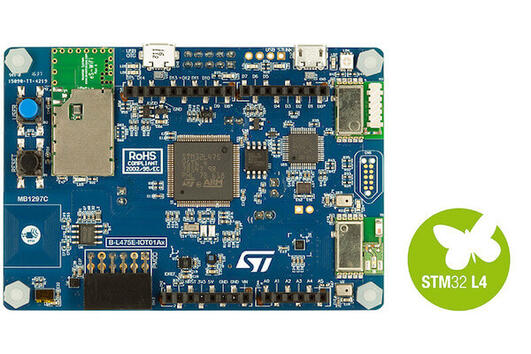ST Disco L475 IOT01 (B-L475E-IOT01A)
Overview
The B-L475E-IOT01A Discovery kit for IoT node allows users to develop applications with direct connection to cloud servers. The Discovery kit enables a wide diversity of applications by exploiting low-power communication, multiway sensing and ARM® Cortex®-M4 core-based STM32L4 Series features.
This kit provides:
64-Mbit Quad-SPI (Macronix) Flash memory
Bluetooth® V4.1 module (SPBTLE-RF)
Sub-GHz (868 or 915 MHz) low-power-programmable RF module (SPSGRF-868 or SPSGRF-915)
Wi-Fi® module Inventek ISM43362-M3G-L44 (802.11 b/g/n compliant)
Dynamic NFC tag based on M24SR with its printed NFC antenna
2 digital omni-directional microphones (MP34DT01)
Capacitive digital sensor for relative humidity and temperature (HTS221)
High-performance 3-axis magnetometer (LIS3MDL)
3D accelerometer and 3D gyroscope (LSM6DSL)
260-1260 hPa absolute digital output barometer (LPS22HB)
Time-of-Flight and gesture-detection sensor (VL53L0X)
2 push-buttons (user and reset)
USB OTG FS with Micro-AB connector
- Expansion connectors:
Arduino™ Uno V3
PMOD
- Flexible power-supply options:
ST LINK USB VBUS or external sources
- On-board ST-LINK/V2-1 debugger/programmer with USB re-enumeration capability:
mass storage, virtual COM port and debug port

More information about the board can be found at the Disco L475 IoT1 website.
Hardware
The STM32L475VG SoC provides the following hardware IPs:
Ultra-low-power with FlexPowerControl (down to 120 nA Standby mode and 100 uA/MHz run mode)
Core: ARM® 32-bit Cortex®-M4 CPU with FPU, frequency up to 80 MHz, 100DMIPS/1.25DMIPS/MHz (Dhrystone 2.1)
- Clock Sources:
4 to 48 MHz crystal oscillator
32 kHz crystal oscillator for RTC (LSE)
Internal 16 MHz factory-trimmed RC ( ±1%)
Internal low-power 32 kHz RC ( ±5%)
Internal multispeed 100 kHz to 48 MHz oscillator, auto-trimmed by LSE (better than ±0.25 % accuracy)
3 PLLs for system clock, USB, audio, ADC
RTC with HW calendar, alarms and calibration
Up to 24 capacitive sensing channels: support touchkey, linear and rotary touch sensors
- 16x timers:
2x 16-bit advanced motor-control
2x 32-bit and 5x 16-bit general purpose
2x 16-bit basic
2x low-power 16-bit timers (available in Stop mode)
2x watchdogs
SysTick timer
Up to 114 fast I/Os, most 5 V-tolerant, up to 14 I/Os with independent supply down to 1.08 V
- Memories
Up to 1 MB Flash, 2 banks read-while-write, proprietary code readout protection
Up to 128 KB of SRAM including 32 KB with hardware parity check
External memory interface for static memories supporting SRAM, PSRAM, NOR and NAND memories
Quad SPI memory interface
4x digital filters for sigma delta modulator
- Rich analog peripherals (independent supply)
2x 12-bit ADC 5 MSPS, up to 16-bit with hardware oversampling, 200 uA/MSPS
2x 12-bit DAC, low-power sample and hold
2x operational amplifiers with built-in PGA
2x ultra-low-power comparators
- 18x communication interfaces
USB OTG 2.0 full-speed, LPM and BCD
2x SAIs (serial audio interface)
3x I2C FM+(1 Mbit/s), SMBus/PMBus
6x USARTs (ISO 7816, LIN, IrDA, modem)
3x SPIs (4x SPIs with the Quad SPI)
CAN (2.0B Active) and SDMMC interface
SWPMI single wire protocol master I/F
14-channel DMA controller
True random number generator
CRC calculation unit, 96-bit unique ID
Development support: serial wire debug (SWD), JTAG, Embedded Trace Macrocell™
- More information about STM32L475VG can be found here:
Supported Features
The Zephyr Disco L475 IoT board configuration supports the following hardware features:
Interface |
Controller |
Driver/Component |
|---|---|---|
NVIC |
on-chip |
nested vector interrupt controller |
UART |
on-chip |
serial port-polling; serial port-interrupt |
PINMUX |
on-chip |
pinmux |
GPIO |
on-chip |
gpio |
FLASH |
on-chip |
flash memory |
I2C |
on-chip |
i2c |
SPI |
on-chip |
spi |
PWM |
on-chip |
pwm |
WATCHDOG |
on-chip |
independent watchdog |
DAC |
on-chip |
DAC Controller |
ADC |
on-chip |
adc |
QSPI NOR |
on-chip |
off-chip flash |
die-temp |
on-chip |
die temperature sensor |
Other hardware features are not yet supported on this Zephyr port.
The default configuration can be found in the defconfig file:
boards/arm/disco_l475_iot1/disco_l475_iot1_defconfig
Connections and IOs
Disco L475 IoT Board has 8 GPIO controllers. These controllers are responsible for pin muxing, input/output, pull-up, etc.
Available pins:
For detailed information about available pins please refer to STM32 Disco L475 IoT1 board User Manual.
Default Zephyr Peripheral Mapping:
UART_1 TX/RX : PB6/PB7 (ST-Link Virtual Port Com)
UART_4 TX/RX : PA0/PA1 (Arduino Serial)
I2C1 SCL/SDA : PB8/PB9 (Arduino I2C)
I2C2 SCL/SDA : PB10/PB11 (Sensor I2C bus)
I2C3 SCL/SDA : PC0/PC1
SPI1 NSS/SCK/MISO/MOSI : PA2/PA5/PA6/PA7 (Arduino SPI)
SPI3 SCK/MISO/MOSI : PC10/PC11/PC12 (BT SPI bus)
PWM_2_CH1 : PA15
USER_PB : PC13
LD2 : PA5
ADC12_IN5 : PA0
ADC123_IN3 : PC2
ADC123_IN4 : PC3
ADC12_IN13 : PC4
ADC12_IN14 : PC5
DAC1_OUT1 : PA4
System Clock
Disco L475 IoT System Clock could be driven by internal or external oscillator, as well as main PLL clock. By default System clock is driven by PLL clock at 80MHz, driven by 16MHz high speed internal oscillator.
Serial Port
Disco L475 IoT board has 6 U(S)ARTs. The Zephyr console output is assigned to UART1. Default settings are 115200 8N1.
Programming and Debugging
Applications for the disco_l475_iot1 board configuration can be built and
flashed in the usual way (see Building an Application and
Run an Application for more details).
Flashing
Disco L475 IoT board includes an ST-LINK/V2-1 embedded debug tool interface. This interface is supported by the openocd version included in the Zephyr SDK since v0.9.2.
Flashing an application to Disco L475 IoT
Here is an example for the Hello World application.
Connect the Disco L475 IoT to your host computer using the USB port, then run a serial host program to connect with your Nucleo board. For example:
$ minicom -D /dev/ttyACM0
Then build and flash the application:
# From the root of the zephyr repository
west build -b disco_l475_iot1 samples/hello_world
west flash
You should see the following message on the console:
$ Hello World! arm
Debugging
You can debug an application in the usual way. Here is an example for the Hello World application.
# From the root of the zephyr repository
west build -b disco_l475_iot1 samples/hello_world
west debug
